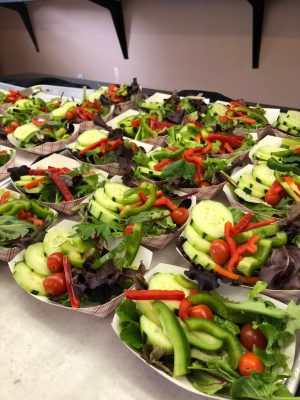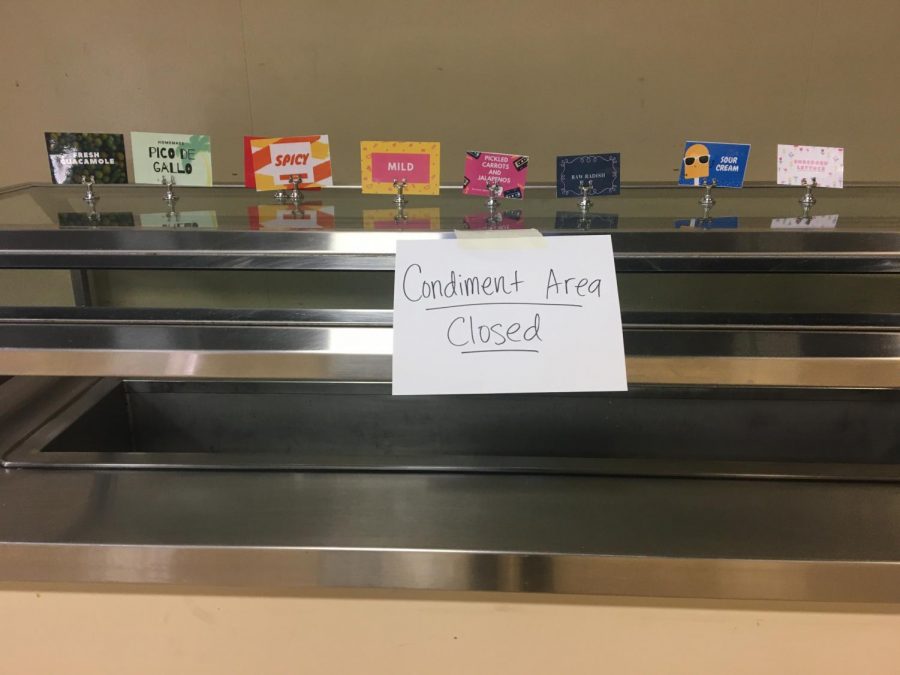Upper school cafeteria limits self-served food items to limit the spread of COVID-19, among other local health measures
The condiment bar in Fresh Mex in the auxiliary gym was closed last Friday as kitchen staff worked to implement a “reduction in self-served items in food service.”
March 9, 2020
The upper school has recently removed self-serve food stations to reduce extra student contact with food due to concerns over the coronavirus.
As of March 6, the salad and fruit bar in Manzanita and Fresh Mex’s condiment station, which includes guacamole and various salsas, in the auxiliary gym now have paper bowls and trays pre-filled with food.
As of March 9, a kitchen worker has been stationed in the gym to spoon guacamole and salsa into student trays to reduce cross contamination. Students were previously able to choose what to include in their dishes in a buffet-like style.
Desserts are also now individually wrapped in small paper bags after the administration announced on Thursday that the school will be implementing a “reduction in self-served items in food service,” which limits the number of tongs passing through the hands of students and faculty on campus.
“We wanted to take an extra step to individually wrap everything,” Adam Albers, pastry chef at the upper school, said. “For the desserts, when we make cookies, we make about a thousand, so bagging those up at three to a bag was about 300 bags just for cookies. It takes a little bit more time to put everything individually, but it’s mostly just prepping.”

Paper trays have replaced the previous buffet-style salad bar in order to prevent the spreading of germs.
The spread of the coronavirus has also affected nearby coffee shops, which have been offering a discount on reusable cups and mugs. Starbucks announced on March 4 that it would temporarily pause the use of personal cups in a series of precautionary steps to limit the spread of the coronavirus.
To stay as safe and healthy as possible, the Center for Disease Control and Prevention (CDC) recommends washing hands before, during and after eating or handling food, when caring for someone who is sick, after using the restroom, after touching animals or pets, when treating a wound and after sneezing or coughing.
According to the CDC, there are five steps to washing hands properly and removing germs: wetting hands with clean, running water, lathering hands with soap, scrubbing for at least 20 seconds (or the length of the “Happy Birthday” song), rinsing hands under clean, running water and drying them with a towel or an air-dryer. The goal of these steps is to create friction using the soap to get rid of dirt, grease and microbes.
If soap and water are not readily available, hand sanitizer is the next best option. Although sanitizer cannot remove all germs, it can significantly reduce the number of them. The CDC advises using hand sanitizer that contains at least 60% alcohol, which should be written on the product’s label.




![LALC Vice President of External Affairs Raeanne Li (11) explains the International Phonetic Alphabet to attendees. "We decided to have more fun topics this year instead of just talking about the same things every year so our older members can also [enjoy],” Raeanne said.](https://harkeraquila.com/wp-content/uploads/2025/10/DSC_4627-1200x795.jpg)


















![“[Building nerf blasters] became this outlet of creativity for me that hasn't been matched by anything else. The process [of] making a build complete to your desire is such a painstakingly difficult process, but I've had to learn from [the skills needed from] soldering to proper painting. There's so many different options for everything, if you think about it, it exists. The best part is [that] if it doesn't exist, you can build it yourself," Ishaan Parate said.](https://harkeraquila.com/wp-content/uploads/2022/08/DSC_8149-900x604.jpg)




![“When I came into high school, I was ready to be a follower. But DECA was a game changer for me. It helped me overcome my fear of public speaking, and it's played such a major role in who I've become today. To be able to successfully lead a chapter of 150 students, an officer team and be one of the upperclassmen I once really admired is something I'm [really] proud of,” Anvitha Tummala ('21) said.](https://harkeraquila.com/wp-content/uploads/2021/07/Screen-Shot-2021-07-25-at-9.50.05-AM-900x594.png)







![“I think getting up in the morning and having a sense of purpose [is exciting]. I think without a certain amount of drive, life is kind of obsolete and mundane, and I think having that every single day is what makes each day unique and kind of makes life exciting,” Neymika Jain (12) said.](https://harkeraquila.com/wp-content/uploads/2017/06/Screen-Shot-2017-06-03-at-4.54.16-PM.png)








![“My slogan is ‘slow feet, don’t eat, and I’m hungry.’ You need to run fast to get where you are–you aren't going to get those championships if you aren't fast,” Angel Cervantes (12) said. “I want to do well in school on my tests and in track and win championships for my team. I live by that, [and] I can do that anywhere: in the classroom or on the field.”](https://harkeraquila.com/wp-content/uploads/2018/06/DSC5146-900x601.jpg)
![“[Volleyball has] taught me how to fall correctly, and another thing it taught is that you don’t have to be the best at something to be good at it. If you just hit the ball in a smart way, then it still scores points and you’re good at it. You could be a background player and still make a much bigger impact on the team than you would think,” Anya Gert (’20) said.](https://harkeraquila.com/wp-content/uploads/2020/06/AnnaGert_JinTuan_HoHPhotoEdited-600x900.jpeg)

![“I'm not nearly there yet, but [my confidence has] definitely been getting better since I was pretty shy and timid coming into Harker my freshman year. I know that there's a lot of people that are really confident in what they do, and I really admire them. Everyone's so driven and that has really pushed me to kind of try to find my own place in high school and be more confident,” Alyssa Huang (’20) said.](https://harkeraquila.com/wp-content/uploads/2020/06/AlyssaHuang_EmilyChen_HoHPhoto-900x749.jpeg)











